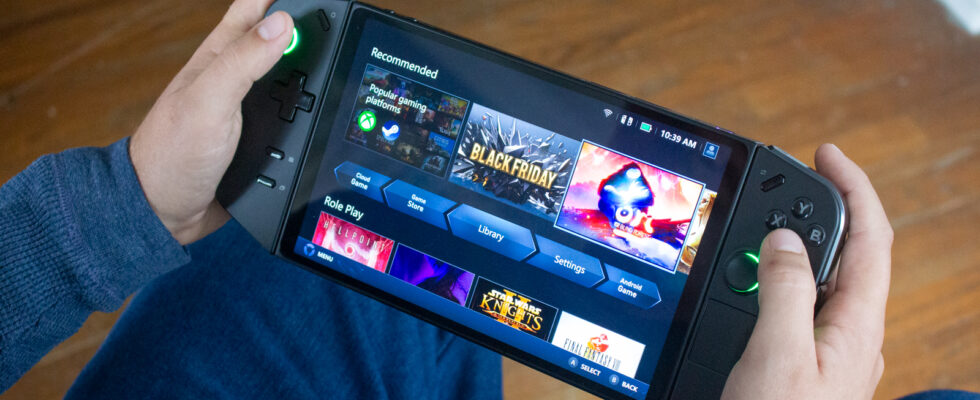The Legion Go, Lenovo’s first portable gaming console, is as much a competitor to the Steam Deck or Nintendo Switch as it is a Windows 11 tablet equipped with game controllers and a fan.
Compared to other handheld gaming consoles, the Legion Go does attempt to be the all-in-one device you could want. But therein lies the biggest question: do people really want the full Windows experience on a device like this?
Key points to remember for the Lenovo Legion Go games console
- The Lenovo Legion Go is Lenovo’s first gaming console/portable PC, priced at €800 with an AMD Ryzen Z1 Extreme chip and 16 GB of RAM.
- This is a very interesting device with all the features aimed at gamers. You can also browse the web like on a traditional computer.
- That said, Lenovo still needs to fix some bugs and software, and so I would recommend a competing handheld console before this one.
The advantages and disadvantages of all in one
During my briefing with Lenovo, it was quickly mentioned that the Legion Go runs Windows 11, meaning you can bypass the custom Legion Space experience and use it as a miniature laptop.
Bluetooth keyboards are obviously supported, and you can use one of the controllers as a mouse. When you’re done, the device transforms again into a Steam Deck alternative, with access to most of your favorite games.
That’s all well and good, but you can’t get a device like this without tinkering with it a little. A lot of custom software had to be developed to support all the weird hardware bits that Lenovo wanted to include, and on top of that, the tablet itself ends up being thick and heavy since it needs powerful specs and a fan to keep it cool.
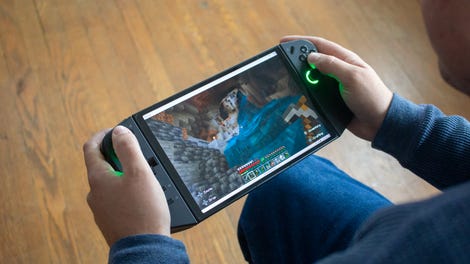
Max Buondonno/ZDNET
Emulate SteamOS as a Windows application
Of course, the Legion Go is capable of serving its primary purpose: gaming. Turn on the device, log in, and you’ll be greeted by Legion Space. It’s Lenovo’s personalized software experience for accessing your game libraries, downloading new titles, and managing your device settings.
It’s a very simplistic user interface that does its best to emulate the personalized experience of something like SteamOS, but in the form of a Windows application.
The 3.3 GHz AMD Ryzen Z1 Extreme processor and Radeon graphics card provide good performance for most games. I’m not a big gamer, but the titles I’ve tried (including Madden And Call of the Wild: The Angler) worked very smoothly.
2560×1600, 144Hz, 500nits
The best part of the experience was the screen: at 8.8 inches, it’s the largest screen you’ll find on one of these portable gaming consoles and it makes every game more immersive. The resolution of 2560×1600, the refresh rate of 144 Hz and the brightness of 500 nits are all assets.
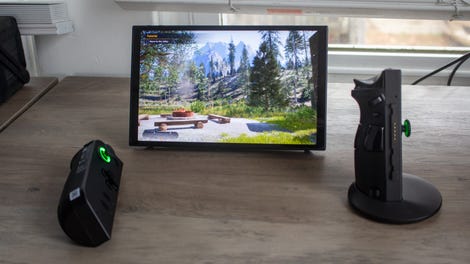
Max Buondonno/ZDNET
During my use, the Legion Go ran hot, but the fan kicked in and cooled things down when needed. The 79-blade fan seemed to do its job properly.
I also liked the TrueStrike controllers (pictured above) provided by Lenovo, which are quite well designed for optimal gaming performance. Detach the controllers (like the Nintendo Switch), open the kickstand on the back of the Legion Go, and you’ll have a great tabletop gaming setup on the go.
The trackpad is nice, but it’s nowhere near as comfortable as a mouse
There’s also a switch that lets you use the right controller for FPS games: simply insert it into the included magnetic base to move the cursor, reposition yourself in games, and more. The trackpad on the right controller is nice, but it’s nowhere near as comfortable as using a mouse.
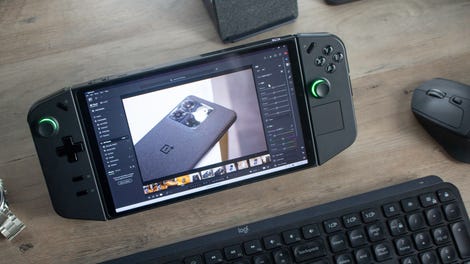
Max Buondonno/ZDNET
Of course, this device runs Windows 11, so you can skip all the gaming aspects, connect a keyboard, and start using it as a miniature laptop replacement. This is what I did, and the experience was quite satisfactory.
Turn on the Legion Go for the first time and you’ll think you’ve just bought a new computer. You have to go through the entire Windows 11 installation experience, which involves connecting your Microsoft account and facing all the Office prompts.
Microsoft has done a decent job of making Windows a little more touchscreen over the years
Microsoft has done a decent job of making Windows a little more tactile over the years, but let’s be honest, this is Windows…you’re supposed to use a mouse and keyboard to control it.
It’s true that you don’t want to work for a long time on an 8.8-inch screen and that you will quickly feel cramped, but to type a few emails or retouch a photo in Lightroom ( yes, I installed Lightroom on this device and it worked perfectly), you can get away with it.
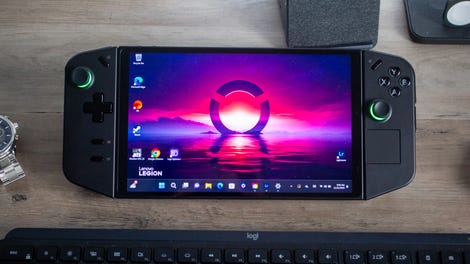
Max Buondonno/ZDNET
Because this is Windows, and Windows treats programs like Lenovo’s Legion Space as a full-screen application and not the main user interface of the system, when I logged into my Steam or Epic account Games, I was often bombarded with pop-ups asking me to go online and download the launchers first.
Two to four hours of battery life on a full charge
All this had to happen by relying on the right joystick, playing the mouse role, and on the virtual keyboard of the screen (which was not displayed in 60% of cases when typing on text boxes )…
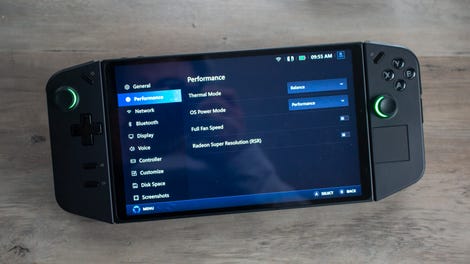
Max Buondonno/ZDNET
During the test, the autonomy of the Legion Go was only two to four hours with a full charge (like the Asus ROG Ally which also works under Windows), even without having opted for the resolution or the highest rates during games.
Did I mention this device is huge? It’s much larger than the Nintendo Switch or Steam Deck, mainly because of its large screen, but also because it has a huge fan that adds weight and thickness. The controllers are thick and bulky, and the whole thing weighs around 900g.
ZDNET’s purchasing advice for the Lenovo Legion Go gaming console
Lenovo has designed a very interesting version of the portable gaming console with the Legion Go. Although it is not perfect, it is an interesting first step towards an alternative to the Steam Deck. I hope Lenovo can make it a little thinner, lighter and give it better battery life in a second version. And it would be nice if they could clean up the software!
For those who want a safer and more stable experience, I also recommend the Asus ROG Ally and Steam Deck OLED. The ROG Ally is far from bug-free, but it has better battery life and a simpler software approach that makes it a more efficient gaming console.
As for the Steam Deck OLED, which also works under Windows 11, it has a more comfortable format and faster performance. Both devices seem more accomplished than the Legion Go, which offers so many possibilities of use that ultimately everything gets a little lost in the crowd.
As long as you keep its many quirks and issues in mind, the Legion Go can be considered a very fun toy to tinker with. If you can appreciate this at $800 (and if you play a little more than me), you’ll enjoy having fun with this thing.
If you prefer to have a portable console that works right out of the box, go for something like the Steam Deck or ROG Ally, or just a more traditional gaming laptop.
Source: “ZDNet.com”
